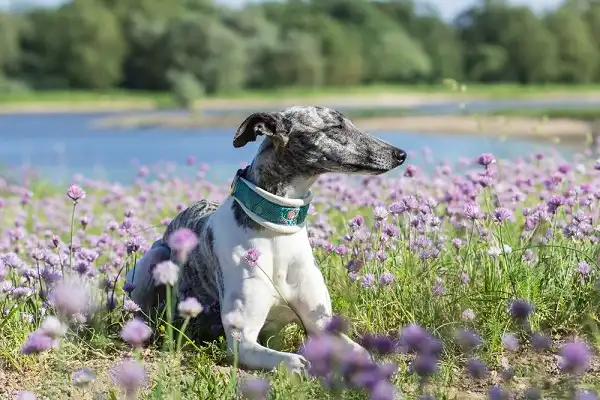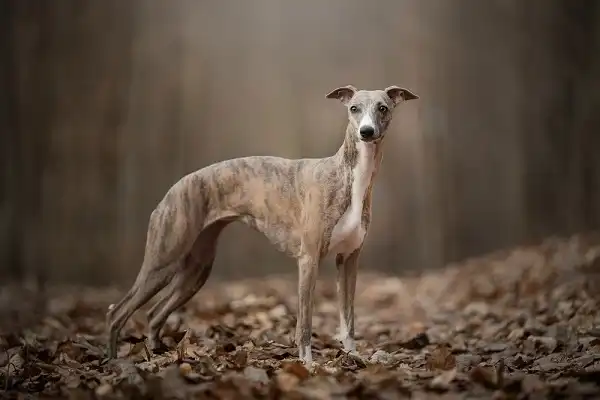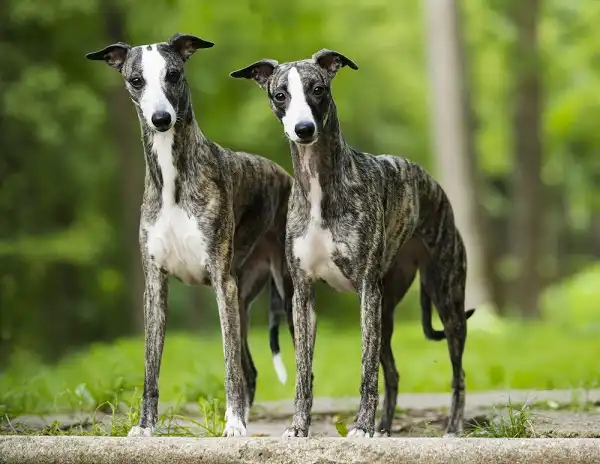The Whippet is an active, intelligent, and loving breed of dog that appeals to many people for its sleek appearance and friendly demeanor. This breed has been around for hundreds of years and was originally used by farmers as a sporting hound. It proved to be an outstanding hunter due to its high speed, agility, and stamina – qualities which it still maintains today. If you’re looking for a pet with the temperament of a larger breed in a compact size, the Whippet could be the perfect choice. So read on to learn more about what makes this unique canine so special!

Whippet Description
The Whippet is a medium-sized sighthound breed known for its elegant appearance, agility, and speed. It has a streamlined body, muscular legs, and a narrow head with a long, tapering muzzle. The Whippet’s coat is short, and smooth, and comes in a variety of colors including fawn, black, white, red, blue, and cream. Whippets are highly intelligent and trainable. They have a keen sense of sight. Due to their quiet and gentle manner, Whippets make great family pets and are excellent with children. They are also well-suited for apartment living, as they don’t require a lot of space to be happy and healthy. One thing to keep in mind when considering a Whippet as a pet is that they do have a high prey drive, so it’s important to leash them when outside and provide plenty of mental stimulation to prevent boredom and destructive behavior. With proper care and training, however, the Whippet can make a loyal and loving companion for families and individuals alike.
Whippet Habitat
The Whippet is a breed of dog that is highly adaptable to different living environments. It is content living in an apartment as long as it is given enough exercise and attention. However, it does need an area to run and play, so if you don’t have a yard, you should take your Whippet to a park or other open space where it can have a good run. Whippets are sensitive to extreme temperatures, whether it’s hot or cold. If you live in an area with harsh winters or very hot summers, you should take extra care to make sure your Whippet is comfortable. This means giving them a warm coat in the winter, and plenty of shade and water in the summer.
Whippet Diet
Whippets have a high metabolism and require a well-balanced diet to maintain their health and energy levels. It’s important to choose a high-quality dog food that provides adequate protein, carbohydrates, and essential nutrients. As with all dogs, it’s best to avoid feeding Whippets table scraps or human food, as this can lead to weight gain and digestive issues. Protein is an important part of a Whippet’s diet, as it helps to build and repair muscle tissue. Look for dog food that contains high-quality sources of protein, like chicken, beef, or fish. Carbohydrates are also important for providing energy, but it’s best to choose complex carbs like sweet potatoes or brown rice rather than simple carbs like white bread or pasta. When it comes to feeding your Whippet, it’s important to follow a feeding schedule and portion control to prevent overeating and weight gain. Depending on the age and activity level of your dog, you should feed them between one to two cups of food per day, divided into two meals. Always make sure your Whippet has access to plenty of fresh water.

Whippet Size
Whippets are a medium-sized breed of dog that typically weigh between 25 and 45 pounds and stand between 18 and 22 inches tall at the shoulder. They have a lean, muscular build with a deep chest and a narrow waist, giving them a sleek and graceful appearance. While Whippets may look delicate, they are actually quite sturdy and resilient. They have a strong skeletal structure and well-developed musculature, which allows them to withstand the rigors of physical activity. They also have a high pain tolerance, which makes them less prone to injury than some other breeds. Despite their size, Whippets make excellent apartment dogs due to their low-maintenance nature and relatively quiet demeanor. They are not prone to excessive barking or destructive behavior and are content to curl up with their humans for hours on end.
Whippet Lifespan
The lifespan of a Whippet is typically between 12 and 15 years, although some have been known to live into their late teens. Like all dogs, the lifespan of a Whippet is influenced by various factors such as genetics, environment, and overall health. To maximize your Whippet’s lifespan, it’s important to provide them with a well-balanced diet, regular exercise, and routine veterinary care. This can help prevent common health issues such as obesity, dental disease, and joint problems. It’s also important to be aware of specific health issues that Whippets may be prone to, such as hypothyroidism, heart murmurs, and eye problems. Regular check-ups with a veterinarian can help detect and manage these issues early, which can improve your Whippet’s quality of life and potentially prolong its lifespan. Overall, while the lifespan of a Whippet can vary, providing them with a healthy and happy lifestyle can help ensure they live a long and fulfilling life as your beloved companion.
Whippet Behavior
Whippets have a reputation for being gentle, loyal, and affectionate dogs. They are known for their sweet and mild-mannered nature, making them excellent family pets. Although they may seem reserved initially, once they warm up to their humans, they become extremely loving and devoted companions. Whippets are also known for their intelligence and trainability. They are quick learners, eager to please their humans, and respond well to positive reinforcement training methods. However, like all dogs, they require consistent and patient training to learn good behaviors and manners. One trait that sets Whippets apart from other breeds is their sensitivity. They are highly in tune with their humans’ emotions and moods and can become anxious or stressed if they sense something is wrong. Therefore, it’s important to create a calm and stable environment for them to thrive. Whippets also crave human companionship and can become lonely if left alone for extended periods. They thrive in households where someone is home most of the time or with other dogs for company. However, it’s important to note that Whippets may not do well in households with very young children, as their gentle nature can make them vulnerable to unintentional rough play.

Whippet Speed
Whippets are known for their remarkable speed and agility. They were originally bred as hunting dogs, specifically for chasing small game, so their swift abilities were crucial to their job. This breed has a lean and muscular body that allows for lightning-fast movement, with their long legs giving them a big stride that propels them forward with grace and ease. Whippets are considered one of the fastest breeds of dogs and excel in various competitions that test their speed and agility, such as lure coursing and racing. In fact, they are capable of reaching speeds of up to 35 miles per hour, which is remarkable considering their size. Additionally, their acceleration is impressive, with a Whippet being able to reach 30 miles per hour in just a few strides. Despite their incredible speed, Whippets are not high-energy dogs by nature. They enjoy a good run or play session but will also happily curl up next to their humans for a snooze afterward.
Whippet Hunting
Whippets were originally bred as hunting dogs, with their swift and agile bodies making them perfect for catching small game like rabbits and hares. Their speed and ability to change direction quickly allowed them to quickly chase and capture prey. In fact, Whippets were often used in pairs or small packs to flush out games and then pursue them at high speeds. Today, Whippets are still used for hunting, primarily in lure coursing competitions. In these events, a mechanical lure is pulled across a field, and the Whippets are released to chase it. The dogs are judged on their speed, agility, and ability to follow the lure. It’s a thrilling sight to watch a pack of Whippets race across the field, their lean bodies stretching out to reach top speeds. While Whippets have a strong prey drive and enjoy chasing small animals, they are also gentle and affectionate dogs. With consistent training and socialization, they can coexist peacefully with cats and other small pets. However, it’s important to remember that their instinct to chase may still kick in, so caution should always be exercised when introducing them to new animals.
Whippet Common health issues
No breed is completely free of health issues, and the Whippet is no exception. They can be prone to joint problems such as lux patellas, as well as eye disorders like cataracts. Responsible breeding practices have reduced the frequency of some disorders in the breed, but it’s still important for pet owners to be aware of common Whippet health issues so they can take steps to keep their dogs healthy and happy. Additionally, due to their deep chest cavity and narrow waist, Whippets are at risk for bloat, a serious condition that can occur if too much air accumulates in the stomach. To reduce this risk, it’s important to feed your dog several small meals throughout the day instead of one large meal. It’s also important to provide your Whippet with regular exercise and mental stimulation. A combination of moderate, daily activity and engaging activities like agility or lure coursing will not only keep your dog physically healthy, but mentally stimulated as well. Taking these steps to ensure the health of your Whippet is the best way to guarantee a long, happy life for your beloved pet.

Whippet Grooming
Whippets are relatively easy to groom, but they do have some specific needs. Because they have short coat and minimal body fat, they can become cold easily in colder climates. This means that it’s important to provide your Whippet with a warm, waterproof coat or sweater when taking them out on cold days. In terms of brushing and bathing, Whippets only require occasional brushing and an occasional bath (every 3-4 weeks). Brushing helps keep the coat clean and removes any dead hair or dirt. When bathing your Whippet, use a mild shampoo specifically designed for dogs to ensure their skin isn’t irritated by harsher products. Finally, regular nail trimming is necessary to keep your Whippet’s feet healthy and free of dirt and debris. If you’re uncomfortable trimming your dog’s nails yourself, take them to a professional groomer or veterinarian who can do it for you. With the right care, your Whippet will keep their beautiful coat and healthy paws for years to come.
Conclusion
Whippets are an amazing breed that is both beautiful and talented. Their powerful, athletic bodies give them the ability to reach incredible speeds, making them perfect for hunting and other canine competitions. Despite their swiftness, they have a gentle nature and make loving pets when given enough attention, exercise, and training. Whether you’re looking for a speedy running partner or a loyal companion to cuddle with at home, Whippets are sure to be an excellent addition to any family.
Frequently Asked Question


